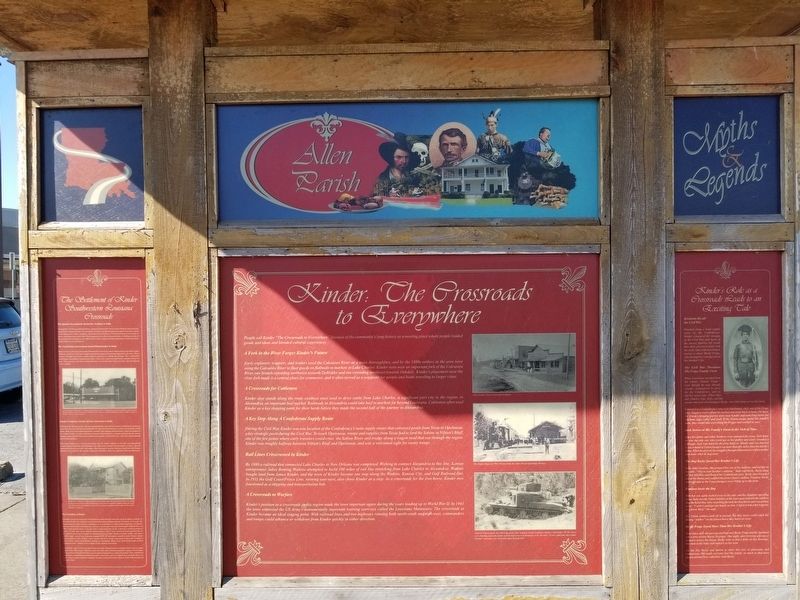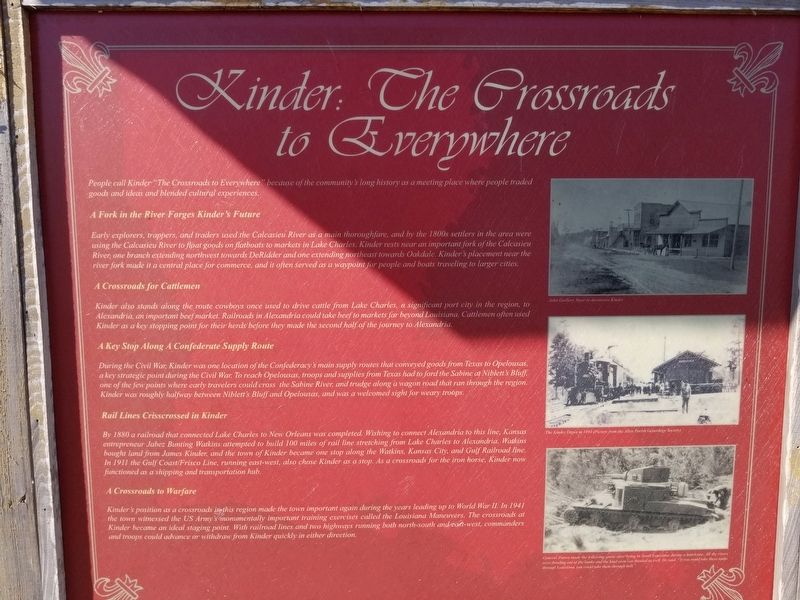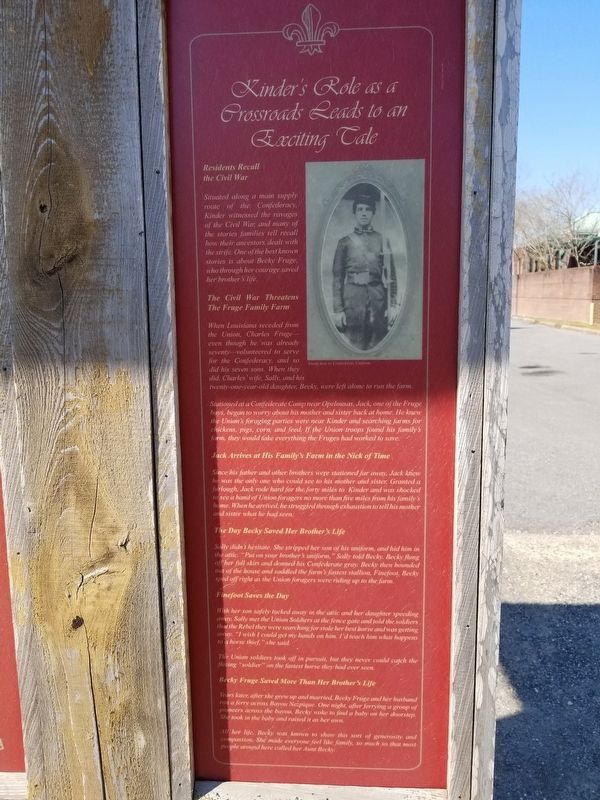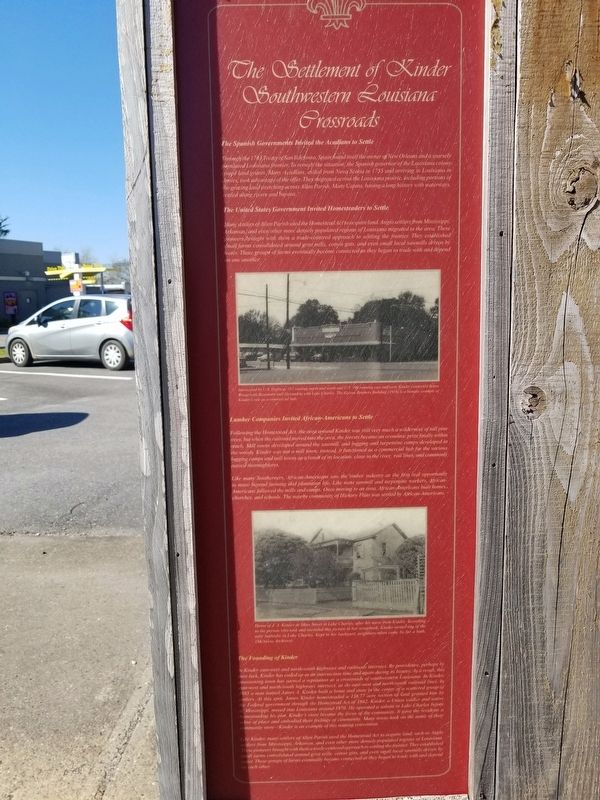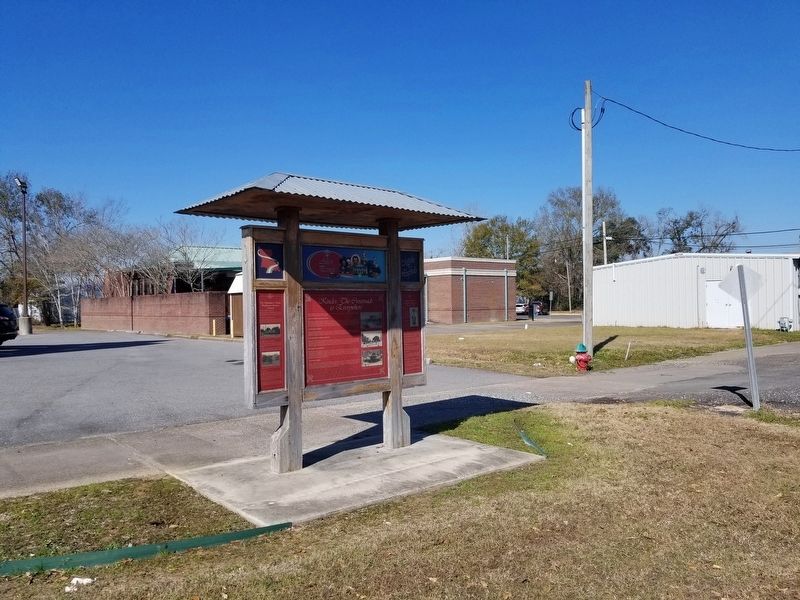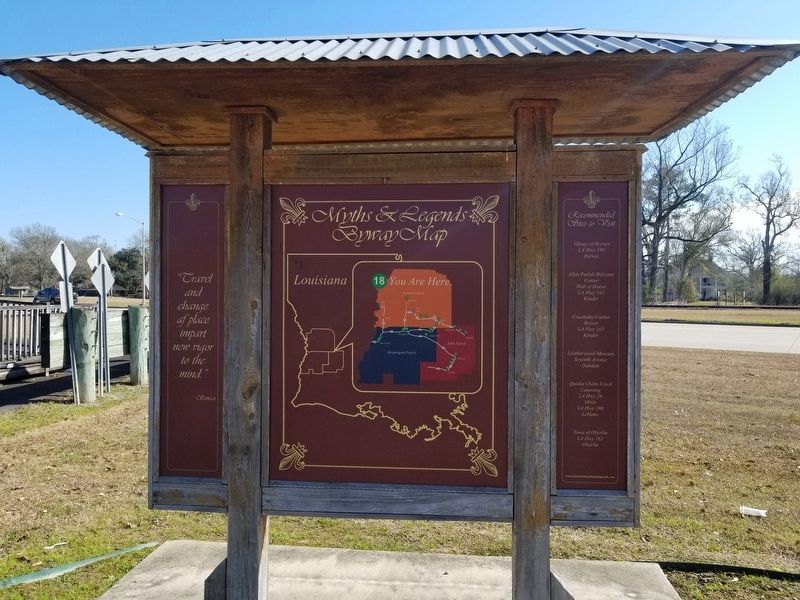Kinder in Allen Parish, Louisiana — The American South (West South Central)
Kinder: The Crossroads to Everywhere
Myths & Legends - Allen Parish
People call Kinder "The Crossroads to Everywhere" because of the community's long history as a meeting place where people traded goods and ideas and blended cultural experiences.
A Fork in the River Forges Kinder's Future
Early explorers, trappers, and traders used the Calcasieu River as a main thoroughfare, and by the 1800s settlers in the area were using the Calcasieu River to float goods on flatboats to markets in Lake Charles. Kinder rests near an important fork of the Calcasieu River, one branch extending northwest towards DeRidder and one extending northeast towards Oakdale. Kinder's placement near the river fork made it a central place for commerce, and it often served as a waypoint for people and boats traveling to larger cities.
A Crossroads for Cattlemen
Kinder also stands along the route cowboys once used to drive cattle from Lake Charles, a significant port city in the region, to Alexandria, an important beef market. Railroads in Alexandria could take beef to markets far beyond Louisiana. Cattlemen often used Kinder as a key stopping point for their herds before they made the second half of the journey to Alexandria.
A Key Stop Along A Confederate Supply Route
During the Civil War, Kinder was one location of the Confederacy's main supply routes that conveyed goods from Texas to Opelousas, a key strategic point during the Civil War. To reach Opelousas, troops and supplies from Texas had to ford the Sabine at Niblett's Bluff one of the few points where early travelers could cross the Sabine River, and trudge along a wagon road that ran through the region. Kinder was roughly halfway between Niblett's Bluff and Opelousas, and was a welcomed sight for weary troops.
Rail Lines Crisscrossed in Kinder
By 1880 a railroad that connected Lake Charles to New Orleans was completed. Wishing to connect Alexandria to this line, Kansas entrepreneur Jabez Bunting Watkins attempted to build 100 miles of rail line stretching from Lake Charles to Alexandria. Watkins bought land from James Kinder, and the town of Kinder became one stop along the Watkins, Kansas City, and Gulf Railroad line. In 1911 the Gulf Coast/Frisco Line, running east-west, also chose Kinder as a stop. As a crossroads for the iron horse, Kinder now functioned as a shipping and transportation hub.
A Crossroads to Warfare
Kinder's position as a crossroads in this region made the town important again during the years leading up to World War II. In 1941 the town witnessed the US Army's monumentally important training exercises called the Louisiana Maneuvers. The crossroads at Kinder became an ideal staging point. With railroad lines
and two highways running both north-south and east-west, commanders
and troops could advance or withdraw from Kinder quickly in either direction.
Right Panel
Residents Recall the Civil War
Situated along a main supply route of the Confederacy, Kinder witnessed the ravages of the Civil War, and many of the stories families tell recall how their ancestors dealt with the strife. One of the best known stories is about Becky Fruge, who through her courage saved her brother's life.
The Civil War Threatens The Fruge Family Farm
When Louisiana seceded from the Union, Charles Fruge- even though he was already seventy-volunteered to serve for the Confederacy, and so did his seven sons. When they did, Charles' wife, Sally, and his twenty-one-year-old daughter, Becky, were left alone to run the farm.
Stationed at a Confederate Camp near Opelousas, Jack, one of the Fruge boys, began to worry about his mother and sister back at home. He knew the Union's foraging parties were near Kinder and searching farms for chickens, pigs, corn, and feed. If the Union troops found his family's farm, they would take everything the Fruges had worked to save.
Jack Arrives at His Family's Farm in the Nick of Time
Since his father and other brothers were stationed far away, Jack knew he was the only one who could see to his
mother and sister. Granted a
furlough, Jack rode hard for the forty miles to Kinder and was shocked
to see a band of Union foragers no more than five miles from his family's
home. When he arrived, he struggled through exhaustion to tell his mother
and sister what he had seen.
The Day Becky Saved Her Brother's Life
Sally didn't hesitate. She stripped her son of his uniform, and hid him in the attic. "Put on your brother's uniform," Sally told Becky. Becky flung off her full skirt and donned his Confederate gray. Becky then bounded out of the house and saddled the farm's fastest stallion, Finefoot, Becky sped off right as the Union foragers were riding up to the farm.
Finefoot Saves the Day
With her son safely tucked away in the attic and her daughter speeding away, Sally met the Union Soldiers at the fence gate and told the soldiers that the Rebel they were searching for stole her best horse and was getting away. "I wish I could get my hands on him. I'd teach him what happens to a horse thief," she said.
The Union soldiers took off in pursuit, but they never could catch the fleeing "soldier" on the fastest horse they had ever seen.
Becky Fruge Saved More Than Her Brother's Life
Years later, after she grew up and married, Becky Fruge and her husband ran a ferry across Bayou Nezpique. One night, after ferrying a
group of
pioneers across the bayou, Becky woke to find a baby on her doorstep.
She took in the baby and raised it as her own.
All her life, Becky was known to show this sort of generosity and compassion. She made everyone feel like family, so much so that most people around here called her Aunt Becky.
Left Panel
The Settlement of Kinder Southwestern Louisiana Crossroads
The Spanish Governments Invited the Acadians to Settle
Through the 1763 Treaty of San Ildefonso, Spain found itself the owner of New Orleans and a sparsely populated Louisiana frontier. To remedy the situation, the Spanish governor of the Louisiana colony issued land grants. Many Acadians, exiled from Nova Scotia in 1755 and arriving in Louisiana in doves, took advantage of the offer. They migrated across the Louisiana prairie, including portions of The grazing land stretching across Allen Parish, Many Cajuns, having a long history with waterways, settled along rivers and bayous.
The United States Government Invited Homesteaders to Settle
Many sellers of Allen Parish used the Homestead Act to acquire land. Anglo settlers from Mississippi Arkansas and even/other more densely populated regions of Louisiana migrated to the areal These pioneers brought with them a trade-centered approach to settling the frontier. They established Small farms consolidated around grist mills, cotton gins, and even small local sawmills driven by water. These groups of farms eventually became connected as they began to trade with and depend on one another
Lumber Companies Invited African-Americans to Settle
Following the Homestead Act, the area around Kinder was still very much a wilderness of tall pine trees, but when the railroad moved into the area, the forests became an economic prize finally within reach. Mill towns developed around the sawmill, and logging and turpentine camps developed in The woods. Kinder was not a mill town; instead, it functioned as a commercial hub for the various logging camps and mill towns as a result of its location, close to the river rail lines, and commonly passed thoroughfares.
Like many Southerners, African-Americans saw the timber industry as the first real opportunity to move beyond farming and plantation life. Like most sawmill and turpentine workers, African- Americans followed the mills and camps. Once moving to an area, African-Americans built homes. churches, and schools. The nearby community of Hickory Flats was settled by African-Americans.
The Founding of Kinder
In Kinder east-west and north-south highways and railroads intersect. By providence, perhaps by pure luck, Kinder has ended up as an intersection time and again during its history. As a result,
this
unassuming town has earned a reputation as a crossroads of southwestern Louisiana. In
1885 a man named James A. Kinder built a home and store in the center of a scattered group of
settlers. At this spot, James Kinder homesteaded a 138.77 acre section of land granted him by
the Federal government through the Homestead Act of 1862. Kinder, a Union soldier and native
of Mississippi, moved into Louisiana around 1870. He operated d saloon in Lake Charles before
homesteading his plot. Kinder's store became the focus of the community. It gave the residents a
sense of place and embodied their feelings of community. Many towns took on the name of their
community store Kinder is an example of this naming convention.
Like Kinder, many settlers of Allen Parish used the Homestead Act to acquire land, such as Anglo settlers from Mississippi, Arkansas, and even other more densely populated regions of Louisiana. These pioneers brought with them a trade-centered approach to settling the frontier. They established small farms consolidated around grist mills, cotton gins, and even small local sawmills driven by water. These groups of farms eventually became connected as they began to trade with and depend on each other.
Topics and series. This historical marker is listed in this topic list: Settlements & Settlers. In addition, it is included in the Louisiana Myths & Legends Byway series list.
Location. 30° 29.216′ N, 92° 50.931′ W. Marker is in Kinder, Louisiana, in Allen Parish. Marker is on U.S. 165 near 9th Street, on the right when traveling south. Touch for map. Marker is in this post office area: Kinder LA 70648, United States of America. Touch for directions.
Other nearby markers. At least 8 other markers are within 9 miles of this marker, measured as the crow flies. Kinder War Monument (within shouting distance of this marker); 1st. Lt. Douglas B. Fournet (within shouting distance of this marker); Great Louisiana Maneuvers' Blue Army Headquarters (about 600 feet away, measured in a direct line); Kinder, Louisiana (about 600 feet away); 1st. Lt. Douglas Bernard Fournet (approx. 2 miles away); The Coushatta People (approx. 2.8 miles away); St. Paul Baptist Church (approx. 4˝ miles away); Elton Veterans Memorial (approx. 9 miles away). Touch for a list and map of all markers in Kinder.
More about this marker. Located at the "Kinder Triangle" in the McDonalds parking lot. At the southern terminus of 9th Street.
Credits. This page was last revised on November 21, 2022. It was originally submitted on July 10, 2022, by Cajun Scrambler of Assumption, Louisiana. This page has been viewed 460 times since then and 79 times this year. Photos: 1, 2, 3, 4, 5, 6. submitted on July 10, 2022, by Cajun Scrambler of Assumption, Louisiana.
